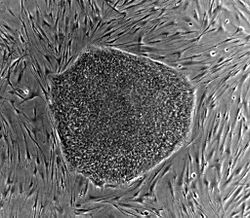
What are embryonic stem cells?
Stem cells derived from embryos are called embryonic stem cells. These stem cells are not derived from eggs fertilized in a woman’s body. But they are fertilized in an in vitro fertilization clinic. The derived embryonic stem cells are donated for research purposes.
The process of growing embryonic stem cells in a laboratory:
Embryonic stem cells are grown in the laboratory by a procedure known as cell culture.Human cells from a preimplantation-stage embryo are transferred into a plastic laboratory culture dish filled with a culture medium. This culture medium is a nutrient broth.
The culture dish is prepared first. The inner surface is coated with mouse skin cells. This coating is called as feeder layer.These cells are known as feeder cells because they release nutrient into the culture medium.The mouse skin cells are treated so that they don’t divide. This coating provides a sticky surface for the cells to attach themselves to the culture dish.
When mouse skin cells are used there is a risk of viruses or other macromolecules be transmitted to the human cells. Researchers now grow embryonic stem cells without mouse feeder cells. This is a milestone in the advancement of the stem cell research.
When these cells survive and start dividing and multiplying, they fill the dish. Once there are enough crowds they are removed and placed into several fresh culture dishes. This is repeated numerous times and for many months. Once the cell line is established, the original cells generate millions of embryonic stem cells. During this process, at any given point, cells can be frozen and shipped to other laboratories for further culture and experiments.
Various laboratory tests are conducted to identify embryonic stem cells. Scientists use a process called characterization to test the cells to determine whether they show the fundamental properties that make them embryonic stem cells.
- By growing and sub-culturing the stem cells over a longer period, scientists ensure that the cells are capable of long-term growth and they have the capability to self-renew themselves. Scientists very often check the culture through a microscope to make sure the cells are healthy and they stay undifferentiated. (unspecialized)
- Scientists look out for transcription factors which are produced by undifferentiated cells. Transcription factors are very important to turn genes on and off at the right time. This is very important for the embryonic development and cell differentiation.
- Scientists test the cells to determine whether they can be re-generate, or sub-cultured, after freezing, thawing and re-plating.
When the embryonic stem cells are grown in culture under right conditions, they remain undifferentiated. When they are allowed to form groups or embryonic bodies, they become specialized to form muscle cells, nerve cells and many other cell types.
Scientists are trying to direct the differentiation of embryonic stem cells into specific cells types. Once this is achieved these differentiated cells can be used to treat certain diseases like Parkinson’s disease, diabetes muscular dystrophy, heart disease and vision and hearing loss.